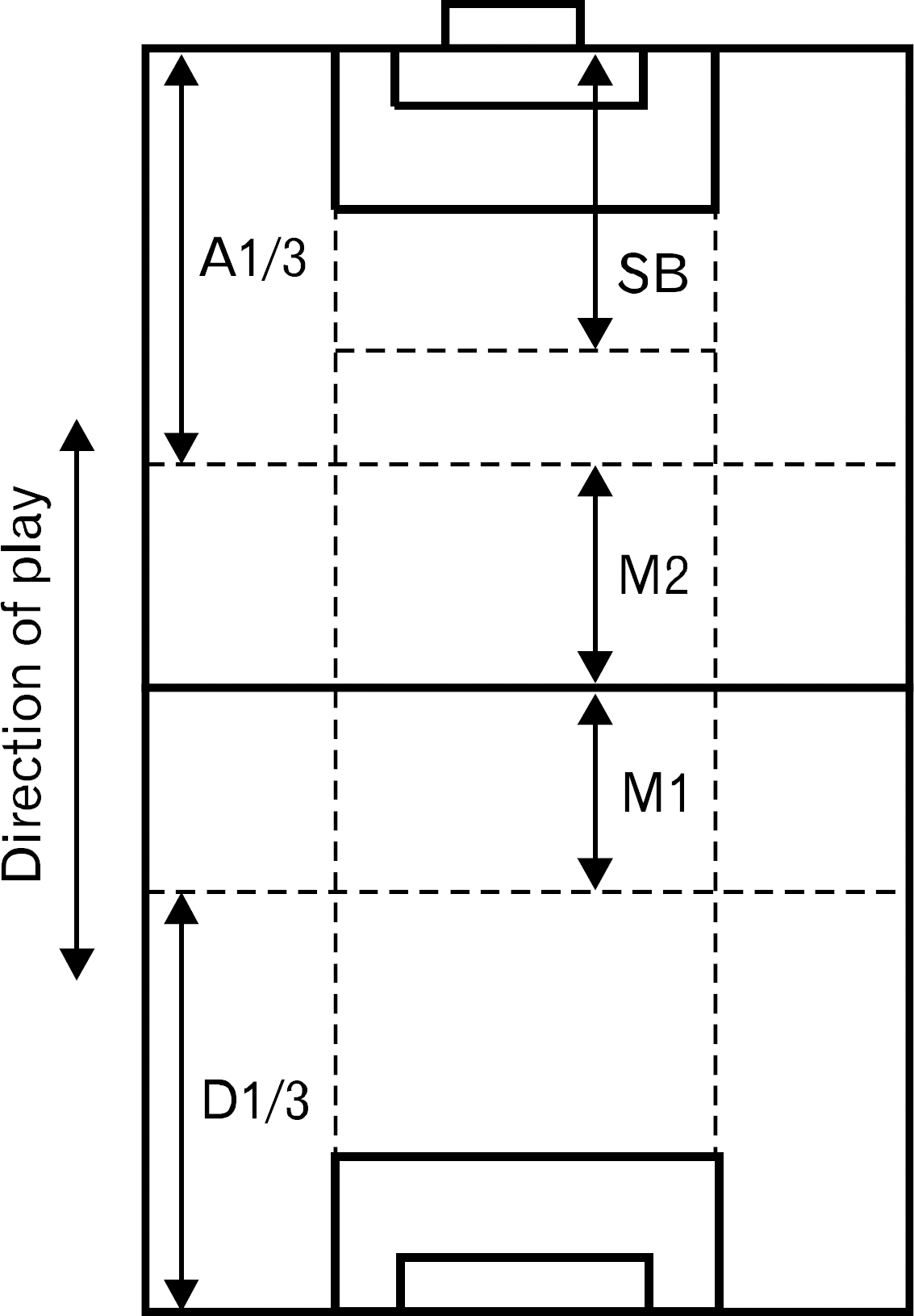Korean J Sports Med.
2013 Jun;31(1):20-25. 10.5763/kjsm.2013.31.1.20.
A Study on Video Analysis of Sports Injuries and Management in Korean Professional Football
- Affiliations
-
- 1Korea National Sport University, Seoul, Korea. sportler@hanmail.net
- KMID: 1838969
- DOI: http://doi.org/10.5763/kjsm.2013.31.1.20
Abstract
- This study describes the characteristics of injuries and high risk situation in the Korean professional soccer matches using the video analysis. Video analysis is a video based method describing incidents and injuries that may result in an injury using 19 variables and categories modified from the soccer matches. During the 2012 season K-league, video files from 60 matches in the Korean professional soccer matches were reviewed. Injuries and Incidents were recorded when the match was interrupted by the referee because of a suspected injury. As results, 201 incidents were recorded in 60 matches. The most injured body part was ankle. The majority of the injury risk incidents occurred during receiving the ball and heading. Midfielders appeared to be at greater risk than others and most incidents and injuries occurred during breakdown attacks and when a player was involved in duels. Also, improved ball handling skill (especially 1st touching the ball) may reduce the incidents and injuries.
Figure
Cited by 1 articles
-
Comparison of Cardiopulmonary Endurance among Positions in Middle School Soccer Players and Their Sports Injuries
Kil-Byung Lim, Jung-Wha Moon, Ji Heoung Lee
Korean J Sports Med. 2013;31(2):63-68. doi: 10.5763/kjsm.2013.31.2.63.
Reference
-
References
1. Manning MR, Levy RS. Soccer. Phys Med Rehabil Clin N Am. 2006; 17:677–95.
Article2. Hagglund M, Walden M, Ekstrand J. Risk factors for lower extremity muscle injury in professional soccer: the UEFA Injury Study. Am J Sports Med. 2013; 41:327–35.3. Hagglund M, Walden M, Ekstrand J. Injuries among male and female elite football players. Scand J Med Sci Sports. 2009; 19:819–27.4. Vlak T, Pivalica D. Handball: the beauty or the beast. Croat Med J. 2004; 45:526–30.5. Glick ID, Horsfall JL. Diagnosis and psychiatric treatment of athletes. Clin Sports Med. 2005; 24:771–81.
Article6. Kim SH. A study of reviewing a trend of Korean sports injury literatures. J Sport Leis Stud. 2008; 34:1029–39.
Article7. Park KH, Lee J. A study on the sports injuries of the soccer club. Korea Sport Res. 2005; 16:319–28.8. Lee KH, Baek YS, Young KW, Kim NM, Kim CY, Park SR. Analysis of the injuries in professional soccer player. Korean J Sports Med. 2000; 18:176–80.9. Kim CS. Sports injuries in the Korean football players. Koran Journal of Sports Science. 2000; 9:759–96.10. Kim JS, Choi EH, Choi EK. The relationship between life stress and sport injuries for soccer players: conjunctive moderating effects of achievement goal orientation and psychological coping skills. Korean J Sports Med. 1999; 17:395–405.11. Olsen E, Larsen O. Use of match analysis by coaches. Reilly T, Bangsbo J, Hughes M, editors. Football and science III. London: E & FN Spon;1997. p. 209–20.12. Hughes M. Notational analysis. Reilly T, editor. Science and soccer. London: E & FN Spon;1996. p. 343–61.13. Andersen TE, Larsen O, Tenga A, Engebretsen L, Bahr R. Football incident analysis: a new video based method to describe injury mechanisms in professional football. Br J Sports Med. 2003; 37:226–32.
Article14. Wong P, Hong Y. Soccer injury in the lower extremities. Br J Sports Med. 2005; 39:473–82.
Article15. Dvorak J, Junge A. Football injuries and physical symptoms. A review of the literature. Am J Sports Med. 2000; 28:S3–9.16. Junge A, Engebretsen L, Mountjoy ML, et al. Sports injuries during the Summer Olympic Games 2008. Am J Sports Med. 2009; 37:2165–72.
Article17. Weightman D, Browne RC. Injuries in eleven selected sports. Br J Sports Med. 1975; 9:136–41.
Article18. The Football Association. Rules of the Association and Laws of the Game: Season 2010–2011 [Internet]. London: The Football Association;c2012. [cited 2013 May 10]. Available from:. http://www.thefa.com/∼/media/Files/TheFAPortal/gover-nance-docs/rules-of-the-association/fa-handbook-season-2010-2011.ashx.19. Surve I, Schwellnus MP, Noakes T, Lombard C. A fivefold reduction in the incidence of recurrent ankle sprains in soccer players using the Sport-Stirrup orthosis. Am J Sports Med. 1994; 22:601–6.
Article20. Fuller CW, Junge A, Dvorak J. A six year prospective study of the incidence and causes of head and neck injuries in international football. Br J Sports Med. 2005; 39(Suppl 1):i3–9.
Article21. Nilsson M, Hagglund M, Ekstrand J, Walden M. Head and neck injuries in professional soccer. Clin J Sport Med. 2013 Jan 23. [Epub].http://dx.doi.org/10.1097/JSM.0b013e31827ee6f8.
Article22. Niedfeldt MW. Head injuries, heading, and the use of head-gear in soccer. Curr Sports Med Rep. 2011; 10:324–9.
Article23. Andersen TE, Tenga A, Engebretsen L, Bahr R. Video analysis of injuries and incidents in Norwegian professional football. Br J Sports Med. 2004; 38:626–31.
Article24. Inklaar H. Soccer injuries. I: Incidence and severity. Sports Med. 1994; 18:55–73.25. Poulsen TD, Freund KG, Madsen F, Sandvej K. Injuries in high-skilled and low-skilled soccer: a prospective study. Br J Sports Med. 1991; 25:151–3.
Article
- Full Text Links
- Actions
-
Cited
- CITED
-
- Close
- Share
- Similar articles
-
- Acute Infrapatellar Fat Pad Injury after Non-contact, Hyperflexion Injury in a Professional Football Player: A Case Report
- Electrocardiographic Abnormalities following Syncope during Warm-up in a Professional Football Player: A Case Report
- Incidence and Characteristics of Immediate Substitutions of Injured Players in Korean Professional Football League Matches
- The Analysis of Global Positioning System Variables Related to Non-contact Injury in College Football Player
- Dementia Pugilistica with Clinical Features of Frontotemporal Dementia and Parkinsonism: Case Report




